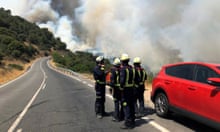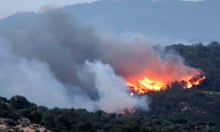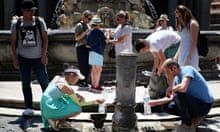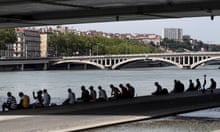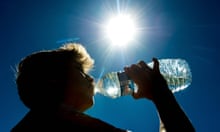France recorded temperatures nearly two degrees higher than its previous record and firefighters continued to battle historic wildfires in Spain as much of western Europe remained in the grip of an extreme early-summer heatwave on Friday.
The French state weather forecaster, Météo-France, said the temperature in Gallargues-le-Montueux in the Gard département hit 45.9C at 4.20pm on Friday.
The previous 2003 record of 44.1C was beaten twice before on Friday: first when the southeastern town of Carpentras reached 44.3C, then hours later when Villevieille, in Provence, hit 45.1C.
“This is historic,” a Météo-France meteorologist, Etienne Kapikian, said. “It’s the first time a temperature in excess of 45C has ever been recorded in France.”
In Germany, the national DWD weather service said overall June temperatures were more than four degrees higher than historic averages for the month and 0.4C higher than the 2003 June average, the warmest since records began in 1881.
The World Meteorological Organisation in Geneva said 2019 was now firmly on course to be among the world’s hottest ever years and that 2015-2019 would then become the hottest five-year period on record.
While it was too soon to definitely attribute the Europe’s current blistering heatwave, which began on Monday, to climate change, it was “absolutely consistent” with extremes linked to the impact of greenhouse gas emissions, the UN agency said.
“Heatwaves will become more intense, they will become more drawn out, they will become more extreme, they will start earlier and they will finish later,” the WMO spokeswoman, Clare Nullis, told journalists.
The French president, Emmanuel Macron, said extreme weather would become more frequent as a result of global warming. “We will need to change our set-up, our way of working, build differently,” he said, stressing a necessary “adaptation of society and its habits”.
Quick GuideHow global heating is causing more extreme weather
Show
Greenhouse gas emissions from burning fossil fuels, forest destruction and other human activities are trapping heat and putting more energy into the climate system.
Hotter air means heatwaves are much more likely. For example, scientists now say the unprecedented heat and wildfires across the northern hemisphere in 2018 “could not have occurred without human-induced climate change”. In Australia, the scorching summer of 2016-17 in New South Wales was made at least 50 times more likely by global heating, linking it directly to climate change.
Hotter air can also carry more water vapour, meaning more intense rain and more flooding.
Another important factor in the northern hemisphere is the impact of changes in the Arctic. The polar region is heating more rapidly, reducing the temperature difference with lower latitudes. There is strong evidence that this is weakening the planetary waves (including the jet stream) that normally meander over Europe, Asia and North America.
When these waves stall, weather gets fixed over regions and becomes extreme. This has been linked to past floods in Pakistan, heatwaves in Russia and drought in California.
Most of the planet’s trapped heat goes into the oceans and rising sea temperatures mean more energy for hurricanes and typhoons. The deluge delivered in the US by Hurricane Harvey in 2017 was made three times more likely by climate change. Rising sea level also means storms cause more coastal damage.
Natural variability would cause some extreme weather, even without global heating, but human impacts on the climate make such extremes more likely. Carbon Brief analysed more than 230 studies and found 95% of heatwaves were made more likely or worse by climate change. For droughts, 65% were definitely affected by our hotter world, while the figure for floods was 57%.
Four administrative départements in France – Vaucluse, Gard, Hérault and Bouches-du-Rhône – were placed on red alert, signalling temperatures of “dangerous intensity” that are more typical of Saudi Arabia.
About 4,000 schools were closed in France as head teachers warned they could not guarantee safe conditions, local authorities cancelled many end-of-school-year carnivals, and nursing homes equipped the elderly with hydration sensors.
“This heat wave is exceptional by its intensity and how early it is,” the prime minister, Edouard Philippe, said, defending authorities’ efforts to avoid a repeat of the notorious 2003 heatwave which caused 15,000 premature deaths.
“I want to appeal to the sense of responsibility of citizens - there are avoidable deaths in every heatwave,” Philippe said. “Measures have been taken for the most vulnerable people but given the intensity of the heat wave, it’s the entire population who must be careful today ... both for oneself and for loved ones and neighbours.”
The French health minister, Agnès Buzyn, warned people tempted to plunge into cold water to do so only in designated public bathing areas, adding that four people had drowned since the beginning of the week.
A six-year-old child was also in life-threatening condition after being hit by water shooting from an illegally opened fire hydrant in the Paris suburb of Saint-Denis, French media reported.
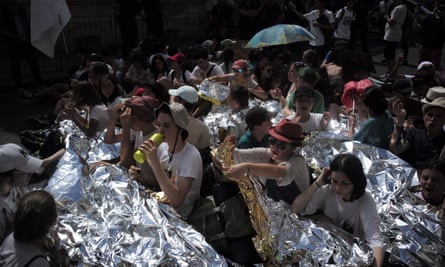
French families with elderly relatives who were ill or living alone were advised to call or visit them twice a day and take them to cool places, while the state-run rail operator SNCF offered free cancellations or exchanges on long-distance trips.
The greater Paris region, Ile de France, had already banned more than half of cars from its roads in an effort to reduce air pollution and the cities of Lyon, Strasbourg and Marseille have also restricted traffic.
With temperatures in parts of Spain expected to hit a new June record of 43C, the Spanish meteorological office issued red alerts in parts of Catalonia, Navarre and the Basque country.
Hundreds of firefighters in Catalonia continued to battle to bring a large wildfire under control which has so far burned through 6,500 hectares of land and could consume as many as 20,000ha.
A 17-year-old Spanish boy died from heatstroke in the early hours of Friday after having convulsions when he jumped into a swimming pool to cool down, while an 80-year-old man died on Thursday after collapsing from what is thought to have been heatstroke in the city of Valladolid.
Italy put 16 cities under alerts for high temperatures, and civil security services distributed water to tourists visiting famed sites around Rome under a scorching sun and in Berlin, a police unit turned water cannon usually used against rioters on city trees to cool them down.
As Germans attempted to cool off amid scorching temperatures, at least four people died in bathing accidents in different parts of the country on Wednesday. Parts of Britain were expected to experience high temperatures on Saturday, with a high of 32C forecast for London.
